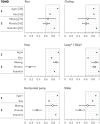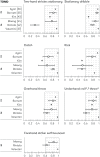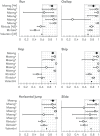Reliability of the test of gross motor development: A systematic review
- PMID: 32673358
- PMCID: PMC7365594
- DOI: 10.1371/journal.pone.0236070
Reliability of the test of gross motor development: A systematic review
Abstract
Objective: To identify, synthesise and evaluate studies that investigated the reliability of the Test of Gross Motor Development (TGMD) variants.
Methods: A systematic search was employed to identify studies that have investigated internal consistency, inter-rater, intra-rater and test-retest reliability of the TGMD variants through Scopus, Pubmed/MEDLINE, PsycINFO, Sport Discus and Web of Science databases.
Results: Of the 265 studies identified, 23 were included. Internal consistency, evaluated in 14 studies, confirming good-to-excellent consistency for the overall score and general motor quotient (GMQ), and acceptable-to-excellent levels in both subscales (locomotor and ball skills). Inter-rater reliability, evaluated in 19 studies, showing good-to-excellent intra-class correlation coefficient (ICC) values in locomotor skills score, ball skills score, overall score, and GMQ. Intra-rater reliability, evaluated in 13 studies, displaying excellent ICC values in overall score and GMQ, and good-to-excellent ICC values in locomotor skills score and ball skills score. Test-retest reliability was evaluated in 15 studies with 100% of the statistics reported above the threshold of acceptable reliability when ICC was not used. Studies with ICC statistic showed good-to-excellent values in ball skills score, overall score, and GMQ; and moderate-to-excellent values in locomotor skills score.
Conclusions: Overall, the results of this systematic review indicate that, regardless of the variant of the test, the TMGD has moderate-to-excellent internal consistency, good-to-excellent inter-rater reliability, good-to-excellent intra-rater reliability, and moderate-to-excellent test-retest reliability. Considering the few high-quality studies in terms of internal consistency, it would be recommend to carry out further studies in this field to improve their quality. Since there is no gold standard for assessing FMS, TGMD variants could be appropriate when opting for a psychometrical robust test. However, standardized training protocols for coding TGMD variants seem to be necessary both for researchers and practitioners in order to ensure acceptable reliability.
Conflict of interest statement
The authors have declared that no competing interests exist.
Figures






References
-
- Gallahue D, Ozmun J, Goodway J. Understanding motor development: infants, children, adolescents, adults. 7th ed New York, NY: McGraw-Hill; 2012.
-
- Hulteen RM, Morgan PJ, Barnett LM, Stodden DF, Lubans DR. Development of Foundational Movement Skills: A Conceptual Model for Physical Activity Across the Lifespan. Sport Med. 2018; 48: 1533–40. - PubMed
-
- Burton A, Miller D. Movement skill assessment. Champaing, IL: Human Kinetics; 1998.
-
- Robinson LE, Stodden DF, Barnett LM, Lopes VP, Logan SW, Rodrigues LP, et al. Motor Competence and its Effect on Positive Developmental Trajectories of Health. Sport Med. 2015; 45: 1273–84. - PubMed
Publication types
MeSH terms
LinkOut - more resources
Full Text Sources
Miscellaneous

